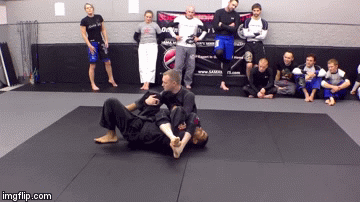
The armbar is one of the most iconic submissions of combat sports. The move is arguably as old as grappling itself and was perfected by the Japanese through years of training. BJJ got it from Judo and evolved it into one of the most effective submission holds of today. The bar works in any setting can be set up from the top and bottom and is not hard to master. This means that it is a go-to move for a lot of people, and even those who do not particularly enjoy it will get it, given the opportunity. Such widespread use of the armbar is precisely why you need to make your armbar escapes count. In that sense, we reduce the clutter to just three escapes, that’ll get you out of the most troublesome armbar tight spots.
Doing the armbar is easy. Escaping the armbar is quite hard. This is what makes this submission so effective. However, it is far from an inescapable move. In terms of armbar escapes, you need to identify what the opponent wants, and you need to know the direction in which to move to deny them. From there on, escaping an armbar gets just as easy as finishing one. Still, many people often get stuck or move in completely the wrong direction. This is down to too many options out there, the majority of which are ineffective against thigh level opponents. Let’s give somersault escapes a rest and focus on three armbar escapes that actually work.
Juji Gatame Trouble
The armbar or Juji Gatame is one of those grappling moves that never lost popularity. Whether you look at a Gracie training room from a few decades ago, or any BJJ academy today, you’ll see at least one armbar during any given roll. The armbar works and people from white o black belt opt to use it more often than not.
But what exactly makes the armbar so effective? The answer is easy – leverage. During an armbar, you have your entire body working against an isolated arm. No wonder how strong the arm is, your body is going to be stronger. Add to this some superior positioning and you can double or triple the power of your body against the muscles of an arm.
Furthermore, the armbar works from virtually any top position, as well as from most open and closed guard variations. This means that people specializing in armbars can hit them from virtually anywhere. The combination of isolation, multiple setups, and great leverage is the trifecta behind the armbars success. That makes armbar escapes easily because the armbars strengths are precisely the main threats you’ll e trying to avoid. So, the first step to escaping armbars would be learning how they work.
John Danaher, as usual, has the ultimate resource for learning the ins and outs of armbars. His armbar DVD instructional is the last part of the widely popular “Enter The System” video series. Check out a complete review of his 8 part instructional and make sure you’re’ among the first to get it at a top price!
Armbar Escapes That Work
When we’re looking at armbar escapes, we need to make sure that we address all the dangers in the correct sequence. In the sense of a fully stretched armbar, you need to know that a tap is the only 100% defense. Other than that, you need to address the leverage first (think opponent’s hips) and arm isolation second to escape. Early defenses include preventing top and bottom setups so you do not end up in an armbar in the first place.
Today’s selection of armbar escapes is going to include three very high-percentage escapes from three different positions. The first is going to be an armbar from the guard known as the stack defense. The second one is the famous “hitchhiker” escape that is as last resort of an escape as possible. Finally, we’ll see a simple and effective way to dismantle the dreaded spiderweb position that’s extremely hard to escape for most people.
The Stack
Starting very basic here, we’ll imagine that you find yourself in an armbar when you’re on top. The setup can be an open or a closed guard, which is not overly important now. Armbar prevention is a topic for another day and another article. For now, we’ll imagine that you’re deep in an armbar from the bottom. Forget about most armbar escapes and focus on the important things. The way an opponent is going to finish an armbar is by extending their hips. The further they can extend their hips, the more leverage they’ll have over your elbow. So, as discussed, leverage first.

When you’re arm is safe from the finish, it’s time to think about escaping completely. At this point, it is all about getting your arm out (i.e.e dealing with arm isolation). Simply wiggle your arm until the point that your elbow is outside of the hips. Now you’re out.
The Hitchhiker
The hitchhiker is one of the armbar escapes that people think they know until they need to use it in a real setting. In order to avoid begin one of those people, you need to make sure you understand the hitchhiker. Getting this escape wrong means you’ll make an armbar worse. So pay attention.

The most important part is the turn itself. When you’re turning, never start from the position you’re in originally. Use your legs to get your body lined up with your opponent’s body. That means your feet and their feet should be in the same direction. Now, you continue rolling over the shoulder of the trapped arm in order to completely get out. The bend in the elbow takes care of leverage, and the turn gets you out of isolation.
Spiderweb Escape
This is the only positional escape we’ll include today, but it is a very important one. Out of all armbar escapes, getting out of the spiderweb armbar is the most difficult one. For this, you need to be careful of both an armbar and a biceps slicer. DOuble the danger means double the caution.

Once you have the leg, it is easy to push the other leg of your head, and turn into the opponent for a direct pass.

Conclusion
In conclusion, armbar escapes are going to work effectively as long as you know and understand armbar attacks. To that extent, the less practical moves you have, the higher the chances of success. So, instead of trying a dozen different armbar escapes, focus on the three that’ll get you out of any armbar situation!


![Darce Choke Encyclopedia – Origins, Mechanics and Variations [2024] BJJ, choke, Brabo, BJJ Darce Choke, D'arce Choke, Darce BJJ Choke](https://bjj-world.com/wp-content/uploads/2017/11/JungPoirierLeeYahoo-218x150.jpg)








![Mastering Control From Top Position Trent Hidlay DVD Review [2024] Mastering Control From Top Position Trent Hidlay DVD Review](https://bjj-world.com/wp-content/uploads/2024/11/control-from-top-position-trent-hidlay-dvd-review-218x150.png)
![Foot Sweep the World Dainis Nguyen-Huu DVD Review [2024] Foot Sweep the World Dainis Nguyen-Huu DVD Review](https://bjj-world.com/wp-content/uploads/2024/11/foot-sweep-the-world-dainis-nguyen-huu-dvd-review-218x150.png)
![Front Headlock and Turtle Escapes Brian Glick DVD Review [2024] Front Headlock and Turtle Escapes Brian Glick DVD Review](https://bjj-world.com/wp-content/uploads/2024/11/headlock-and-turtle-escapes-brian-glick-dvd-review-218x150.png)
![Basic Closed Guard Jasmine Rocha DVD Review [2024] Basic Closed Guard Jasmine Rocha DVD Review](https://bjj-world.com/wp-content/uploads/2024/11/basic-closed-guard-jasmine-rocha-dvd-review-218x150.png)
![Don’t Stand Up Chris Wojcik DVD Review [2024] Don't Stand Up Chris Wojcik DVD Review](https://bjj-world.com/wp-content/uploads/2024/11/dont-stand-up-chris-wojcik-dvd-review-218x150.png)
![EMU Guard 2.0 Benjamin Power DVD Review [2024] EMU Guard 2.0 Benjamin Power DVD Review](https://bjj-world.com/wp-content/uploads/2024/11/emu-guard-2-0-benjamin-power-dvd-review-218x150.png)





![Front Headlock and Turtle Escapes Brian Glick DVD Review [2024] Front Headlock and Turtle Escapes Brian Glick DVD Review](https://bjj-world.com/wp-content/uploads/2024/11/headlock-and-turtle-escapes-brian-glick-dvd-review-100x70.png)
![Feet Finder Foot Sweeps Christian Ozbek DVD Review [2024] Feet Finder Foot Sweeps Christian Ozbek DVD Review](https://bjj-world.com/wp-content/uploads/2024/09/feet-finder-foot-sweeps-christian-ozbek-dvd-review-100x70.png)
![Charles Allan Price Building Workouts For BJJ DVD Review [2024] Charles Allan Price Building Workouts For BJJ DVD Review](https://bjj-world.com/wp-content/uploads/2024/09/charles-allan-price-building-workouts-for-bjj-review-100x70.png)
![Giancarlo Bodoni DVD Bundle Essential Connections Full Review [2024] Giancarlo Bodoni DVD Bundle Essential Connections Full Review](https://bjj-world.com/wp-content/uploads/2024/09/giancarlo-bodoni-dvd-bundle-essential-connections-100x70.png)


![Countering Triangles And Omoplatas Adam Mazin DVD Review [2024] Countering Triangles And Omoplatas Adam Mazin DVD Review](https://bjj-world.com/wp-content/uploads/2024/10/countering-triangles-and-omoplatas-adam-mazin-dvd-REVIEW-100x70.png)


![Jeff Higgs Self Defense Guard BJJ DVD Review [2024] Jeff Higgs Self Defense Guard BJJ DVD Review](https://bjj-world.com/wp-content/uploads/2024/09/jeff-higgs-self-defense-guard-bjj-dvd-review-100x70.png)




![Foot Sweep the World Dainis Nguyen-Huu DVD Review [2024] Foot Sweep the World Dainis Nguyen-Huu DVD Review](https://bjj-world.com/wp-content/uploads/2024/11/foot-sweep-the-world-dainis-nguyen-huu-dvd-review-100x70.png)

![Nicholas Meregali No-Gi System DVD Unpacked: A Detailed Review [2024] Nicholas Meregali No-Gi System DVD Unpacked: A Detailed Review](https://bjj-world.com/wp-content/uploads/2024/09/nicholas-meregali-no-gi-system-dvd-unpacked-review-100x70.png)




![Double Sleeve Guard Jon Thomas BJJ DVD Review [2024] Double Sleeve Guard Jon Thomas BJJ DVD Review](https://bjj-world.com/wp-content/uploads/2024/10/double-sleeve-guard-jon-thomas-bjj-dvd-review-100x70.png)
![Efficiently Executing X-Guard Giancarlo Bodoni DVD Review [2024] Efficiently Executing X-Guard Giancarlo Bodoni DVD Review](https://bjj-world.com/wp-content/uploads/2024/09/efficiently-executing-x-guard-giancarlo-bodoni-dvd-REVIEW-100x70.png)